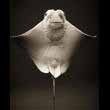Articles
ANIMALIA Collection on view now at MLS
Posted on Monday, February 1, 2010

In 2006, the Harvard Museum of Natural History initiated a series of photography exhibitions designed as “lessons in looking.†A departure from the genre of nature photography that presents pristine and timeless landscapes, populated by wildlife but (as yet) unaffected by man, these shows were intended to be provocative, to change the frame. Our goal was to encourage visitors to pay attention to the details, to ask new questions, to understand—to see—the natural world differently. We were inspired in part by the famous story of Harvard scientist Louis Agassiz, who commanded a beleaguered student to use close observation as a tool for inquiry. “Look, look, look,†he is reported to have insisted.

Looking at Animals, which presents 19 of the photographs here, was the second exhibition in the series, and it succeeded as a lesson in looking on both scientific and artistic grounds. Horenstein’s creatures are decontextualized. They appear without the backdrop of the natural landscape, outside even the artificial world of the zoo or aquarium, and devoid of their true color. As a consequence, the images are truly arresting; and in both a literal and a metaphorical sense, we see these animals as we have never seen them before. We notice details, and Horenstein focuses our vision on the unexpected: the foot of an elephant, the eye of an octopus, the hair on the back of a gibbon’s head, the pattern of feathers on a bird’s neck. He plays with scale: the rear end and tail of a rhinoceros occupy the entire picture frame. We see these as if through a magnifying glass. His pictures challenge us to look more closely, to ask questions and make connections. We think about form and function: the relationship between an elephant’s foot, a horse’s hoof, and our own toes. We ponder modes of sensing and communication: the signals that hold together a school of fish. Examining these photographs, we become scientists and discoverers.

In some respects, Horenstein’s work continues a centuries-old tradition of natural history illustration in the realm of photography. In natural history illustration, animals are often presented in shallow space with limited landscape, sometimes even against a blank page, in order to promote close examination and study of detail. But as much as these photographs promote scientific inquiry, they are more than scientific illustration. Animals were the subjects of our first art and our first metaphors; and freed from the constraints of space and time, many of Horenstein’s creatures remind us of the lost magical connection between the “animal world†and our own. They are unsettling and they mesmerize. They transcend and transgress familiar boundaries between subject and object. Who is observing whom? The Komodo dragon looks at us with piercing eyes. We’re transfixed by the gaze of the harbor seal.

The combination of the scientific and the metaphorical, the artistic and the analytical in these images is what accounts for their extraordinary power. On exhibit in a natural history museum, Horenstein’s photographs offered a new perspective to visitors, transforming the experience of observing specimens in the galleries. They are equally evocative and compelling in this volume.
—Elisabeth Werby
Executive Director, Harvard Museum of Natural History
Cambridge, MA
Modern Living Supplies has the 6 of the last limited edition Ilfochrome prints from this collection on display and for sale now along with signed copies and the limited edition of the Pond Press published ANIMALIA hard cover book also for sale. Please inquire for pricing and availability.
Related links
http://www.animaliabook.com
http://www.pondpress.com
http://www.horenstein.com/
Leave A Comment
The email address you provide will never be sold, rented, given, or otherwise made available to other sites, mailing lists, or third parties.
Fields marked with * are required.
Latest Articles
- 01.20.12
- Facebook…Like MLS
- 02.01.10
- ANIMALIA Collection on view now at MLS
- 01.27.10
- Loft Apartment Home Office Unit
- 06.30.09
- MLS Web Storefront Launch Is Live
- 06.17.09
- 5Americans Opening at Fashionhaus
- 04.22.09
- Modern Living Made Easy By Brad Ford
Latest Comments
- 05.14.09
- Jad on “MLS Web Storefront Launch Is Live”
- 04.30.09
- dylan griffin on “MLS Web Storefront Launch Is Live”
- 04.30.09
- Peter David on “MLS Web Storefront Launch Is Live”
- 04.29.09
- joey nigh on “MLS Web Storefront Launch Is Live”
- 04.28.09
- abhr on “MLS Web Storefront Launch Is Live”
- 04.27.09
- mn brooklyn on “MLS Web Storefront Launch Is Live”
- 04.27.09
- DFB on “MLS Web Storefront Launch Is Live”

Comments
Be the first to post a comment!